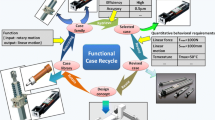Abstract
This paper presents a prototype intelligent system, the knowledge-based functional design automation system (KBFDA) for automating the functional design process of engineering products/systems. An integrated knowledge representation scheme combines rule-based and object-oriented representation methods to represent functions and function related design characteristics in an intelligent design environment. A knowledge-based functional reasoning strategy uses this representation to automatically generate physical behaviors from desired functions or behaviors. The required behaviors are then combined in different configurations to develop a set of potential concept variants that meet the functional requirements and functional constraints given in a design specification. Finally, the variants are ranked according to the degree to which they meet non-functional constraints. The variant with the lowest rank (score) is selected as the best solution. A case study design of a terminal insertion unit is presented to demonstrate the practicality of the proposed approach.
Similar content being viewed by others
References
Akagi, S. and Fujita, K. (1990) Building an expert system for engineering design based on the object-oriented knowledge representation concept. Journal of Mechanical Design, 112, 215-222.
Arpaia, P., Betta, G., Langella, A. and Vanacore, M. (1995) Expert system for the optimum design of measurement systems. IEEE Proceedings on Science, Measurement and Technology, 142, 330-336.
Booch, G. (1994) Object-Oriented Analysis and Design with Applications, 2nd Edn, Benjamin Cummings, Redwood City, California.
Chakrabarti, A., Bligh, T. and Holden, T. (1992) Towards a decision-support framework for the embodiment-phase of mechanical design. Artificial Intelligence in Engineering, 7, 21-36.
Deng, Y.-M. (2000) Functional Design of Mechanical Products: Design Model and Modeling Framework, PhD thesis, Nanyang Technological University, Singapore.
Deng, Y.-M., Britton, G. A. and Tor, S. B. (1999) A computerized design environment for functional modeling of mechanical products, in 5th ACM Symposium on Solid Modeling, Ann Arbor, Michigan, USA, pp. 1-12.
Dewhurst, P. and Boothroyd, G. (1987) Design for assembly in action. Assembly Engineering, 30(1), 64-68.
Gelsey, A., Schwabacher, M. and Smith, D. (1998) Using modeling knowledge to guide design space search. Artificial Intelligence, 101, 35-62.
Giarratano, J. and Riley, G. (1998) Expert Systems: Principles and Programming, 3rd Edn, PWS, Boston.
Gorti, S. R., Gupta, A., Kim, G. J., Sriram, R. D. and Wong, A. (1998) An object-oriented representation for product and design process. Computer Aided Design, 30(7), 489-501.
Huang, K., Ismail, H. S. and Hon, K. K. B. (1996) Automated design of progressive dies. Proceedings of the Institution of Mechanical Engineers, Part B: Journal of Engineering Manufacture, 210,(B4), 367-376.
Kusiak, A. and Szczerbicki, E. (1990) A formal approach to design specifications, in Ravani, B. (ed.), Advances in Design Automation, ASME, Vol. 1, pp. 311-316.
Li, C. L., Tan, S. T. and Chan, K. W. (1996) A qualitative and heuristic approach to the conceptual design of mechanisms. Engineering Application of Artificial Intelligence, 9(1), 17-31.
Markus, A. (1986) AI tools for intelligent manufacturing. Robotics and Computer-Integrated Manufacturing, 3(2), 263-268.
Meyer, B. (1988) Object-Oriented Software Construction, Prentice-Hall, New York.
Pahl, G. and Beitz, W. (1996) Engineering Design—A Systematic Approach, Springer-Verlag, London.
Prabhakar, S. and Goel, A. (1998) Functional modeling for enabling adaptive design of devices for new environments. Artificial Intelligence in Engineering, 12, 417-444.
Rasmussen, J. (1986) Information Processing and Human-Machine Interaction: An Approach to Cognitive Engineering, North-Holland, Amsterdam.
Tong, C. and Gomory, A. (1993) A knowledge based computer environment for the conceptual design of small electromechanical appliances. Computers, 26(1), 69-71.
Tor, S. B., Britton, G. A., Chandrashekar, M. and Ng, K. W. (1998) Functional design, in John Usher, Utpal Roy and Hamid Parsaei (eds), Integrated Product and Process Development: Methods, Tools and Technologies, John Wiley & Sons, New York, pp. 29-58.
Umeda, Y., Takeda, H., Tomiyama, T. and Yoshikawa, H. (1990) Function, behavior and structure, in Gero, J. S. (ed.), Applications of Artificial Intelligence in Engineering V, pp. 177-193.
Zhang, W. Y., Britton, G. A. and Tor S. B. (2001) A prototype knowledge-based system for the conceptual synthesis of design process. International Journal of Advanced Manufacturing Technology, 19(8), 549-557.
Author information
Authors and Affiliations
Rights and permissions
About this article
Cite this article
Zhang, W.Y., Tor, S.B. & Britton, G.A. Automated functional design of engineering systems. Journal of Intelligent Manufacturing 13, 119–133 (2002). https://doi.org/10.1023/A:1014584213713
Issue Date:
DOI: https://doi.org/10.1023/A:1014584213713




